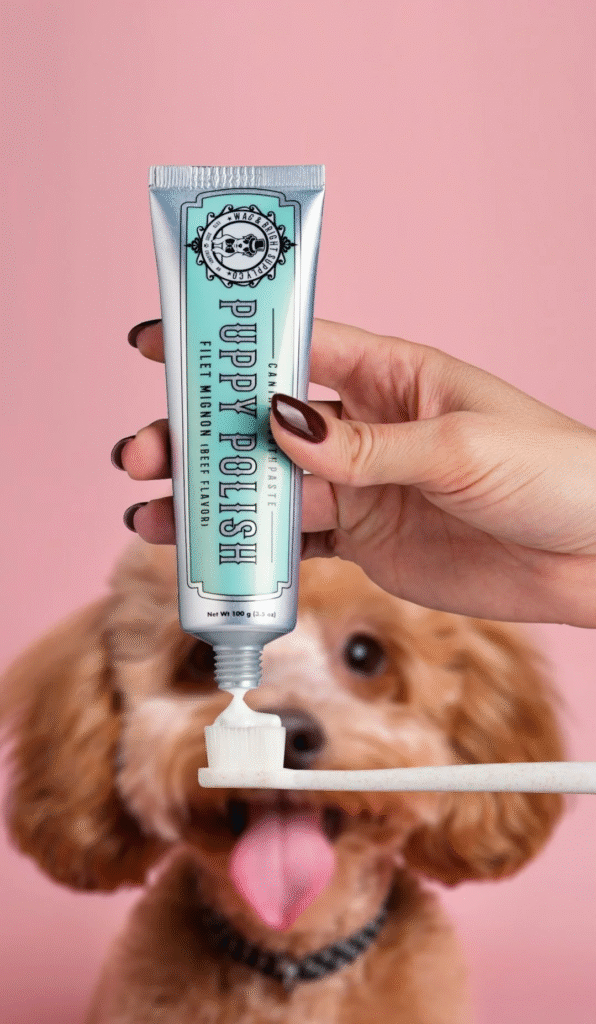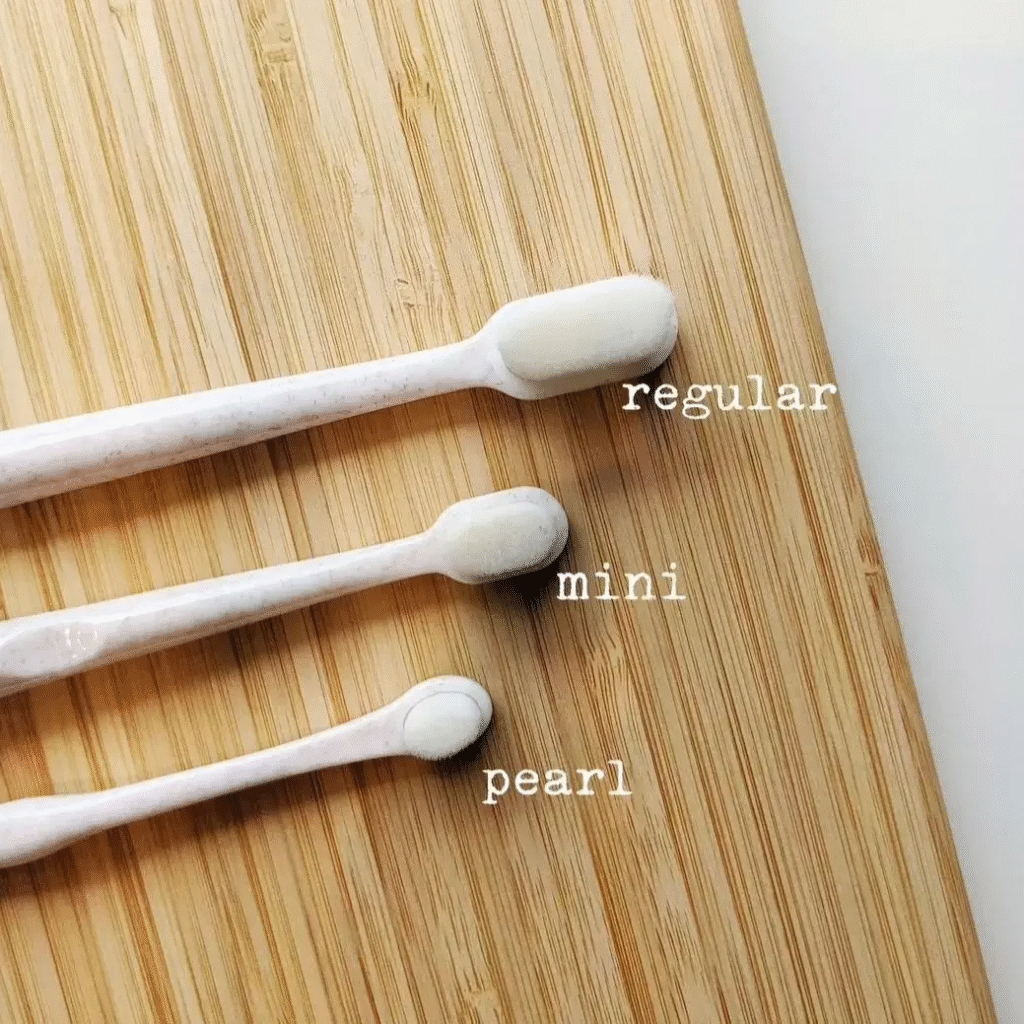Disclaimer: Always consult your veterinarian for any medical concerns with your canine companion. The information offered here is not a substitute for regular dental checks with your vet, or grooming concerns, but instead offers support for healthy hygiene habits you can safely perform at home.
Brush Fur Regularly – every day or two is necessary for some breeds, while once or twice weekly is okay for others. If you start noticing more knots/mats (can happen with seasonal or other environmental changes), increase the frequency until you find a balance which works for their coat.
If your dog enjoys swimming, be sure to brush them out afterwards (preferably when dry to not damage individual hairs), and check for exposure to algae, parasites, and other underwater risks, if applicable.
Tools Required: comb, brush, blunt hair scissors
Brushing helps prevent mats, removes loose fur (more brushing = less vacuuming), and keeps your dog’s coat shiny. The correct comb and brush varies with coat type- choosing the best fit for your dog’s coat will help make the experience positive for both of you.
What to Do with Knots & Matting: starting at the base of the tail, comb through their fur in medium-length strokes, ensuring you get right down to their skin, but not putting pressure on the skin. If you feel any knots, remove comb gently and don’t try to pull it through the knot. Use the brush in short strokes to see if you can work it out, but watch you’re not pulling on your pupperoo’s skin. If the knot/mat cannot be removed with the brush, use the blunt-tip scissors to safely cut out the impacted area: while placing the comb between the skin and the mat to ensure you don’t touch skin with the scissors, cut tiny bits at a time, above the comb until it’s completely cut out. Be sure to regularly comb over the area while fur grows back to prevent the new growth from tangling again.
Daily-weekly brushing will help prevent tangles, making life easier on both of you…and your groomer!



Made in Germany. Available at Le Pooch Boutique.
Brush Fur Regularly – every day or two is necessary for some breeds, while once or twice weekly is okay for others. If you start noticing more knots/mats (can happen with seasonal or other environmental changes), increase the frequency until you find a balance which works for their coat.
If your dog enjoys swimming, be sure to brush them out afterwards (preferably when dry to not damage individual hairs), and check for exposure to algae, parasites, and other underwater risks, if applicable.
Tools Required: comb, brush, blunt hair scissors
Brushing helps prevent mats, removes loose fur (more brushing = less vacuuming), and keeps your dog’s coat shiny. The correct comb and brush varies with coat type- choosing the best fit for your dog’s coat will help make the experience positive for both of you.
What to Do with Knots & Matting: starting at the base of the tail, comb through their fur in medium-length strokes, ensuring you get right down to their skin, but not putting pressure on the skin. If you feel any knots, remove comb gently and don’t try to pull it through the knot. Use the brush in short strokes to see if you can work it out, but watch you’re not pulling on your pupperoo’s skin. If the knot/mat cannot be removed with the brush, use the blunt-tip scissors to safely cut out the impacted area: while placing the comb between the skin and the mat to ensure you don’t touch skin with the scissors, cut tiny bits at a time, above the comb until it’s completely cut out. Be sure to regularly comb over the area while fur grows back to prevent the new growth from tangling again.
Daily-weekly brushing will help prevent tangles, making life easier on both of you…and your groomer!
Brush Those Toofers!
Use a dog-friendly toothpaste (never use human toothpaste for your dog- ingredients can be fatal), and dog-friendly brush.
My Routine with Archie: he LOVES this coconut oil-strawberry toothpaste by Good Girl Good Boy (made in Québec), and comes running when I grab the jar. I use this toothbrush by Wag & Bright (3 sizes available- we use the medium for mini poodle), which is very effective, and I’ve found it more comfortable for him and me compared to others I’ve tried in the past.
1. Have a little bowl of water handy for dipping the brush.
2. Dip the brush in the toothpaste (amount will depend upon your dog’s size, and style of paste).
3. Lift/pull down each side of their mouth with one hand while the other brushes up and down, being sure to get their gums as well. Give a good-but-gentle scrub to teeth and gums,
4. I always finish with the front teeth, since it seems to cause a little more licking than the sides…sticking to the same routine lets him know when we’re nearing the end so he can start bouncing around again.
This simple routine can be a game-changer as your dog ages- dental health can have a major impact on overall health for many. Majority of dogs show signs of gum disease by the time they’re three years old, which can cause kidney and other issues down the road.
Prevention is key…and frequency matters. Don’t rely on just dental chews to keep tartar away…they cannot reliably reach all the places they need to…especially if your pup has a sensitive area and avoids chewing with those particular teeth. That said, there are water additives and powders which are formulated to help promote growth of healthy bacteria, which may improve their breath.



Check Ears and Eyes
Ears: Some breeds have ears which end up filling with their own hair, which can cause hearing loss or be a site for chronic infection. Do a spot check every couple days to ensure their ears are free of obstructions, and odours. If their hair has grown in, it may need to be professionally plucked, but you can take care of on-going maintenance at home by checking the ear canal often (I trim Archie’s ear hair every 10 days or so, with blunt-tipped scissors and comb, as outlined above for removing knots- same idea so skin isn’t touched by the blade). If you notice a strong odour, a trip to your vet may be in order to determine the source – whether it’s fungal (yeasty) or bacterial will determine your next steps.
On-going ear health can involve using ear wipes regularly with just a cotton cosmetic pad, making sure to never go into the canal (risk of injury).
Eyes: Many dogs just need their eye-goo removed with a tissue every day or two, but some will show signs of needing more eye care. Keep nearby hair trimmed back (groomer trip may be in order if you’re not comfortable with working around your pooch’s eyes with clippers or scissors), and clean from debris. If you wish to use any topical solution to help keep your dog’s face clean, make sure it’s formulated for their skin – never use human products on dogs.
Frequent-Use Grooming Gear Available at Le Pooch Boutique
Wag & Bright Dog Toothbrush (available in 3 sizes)
🇨🇦 Cheeks Ahoy Reusable Facial Rounds w/Laundry Bag
🇨🇦 Cheeks Ahoy Bulk Cotton Cloths
🇨🇦 Good Girl Good Boy Coconut Toothpaste Strawberry or Banana
🇨🇦 Good Girl Good Boy Natural Ear Cleaner
Artero 7″ Comb Short-Tooth or Long-Tooth
🇨🇦 = Made in Canada
